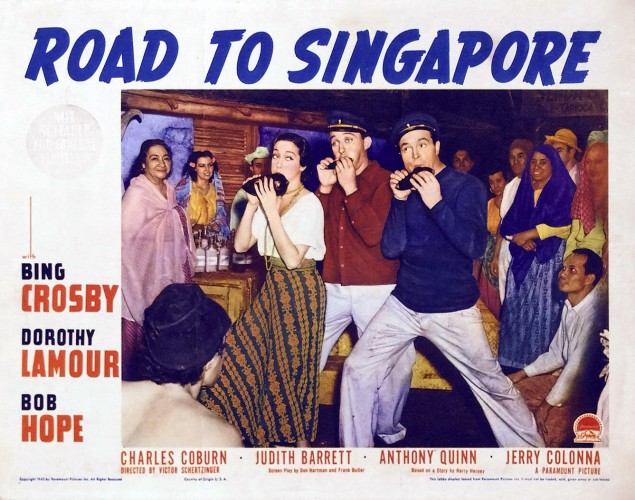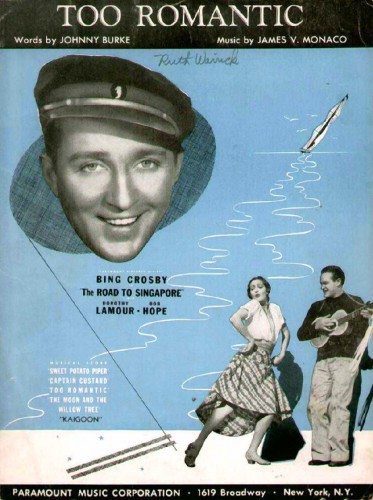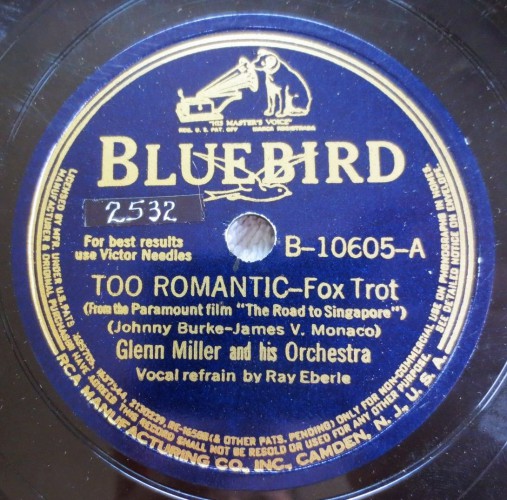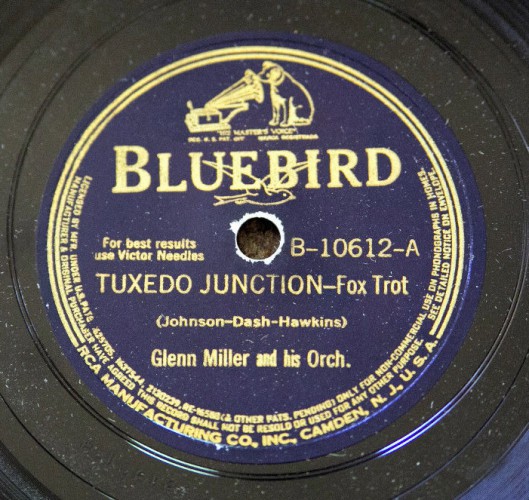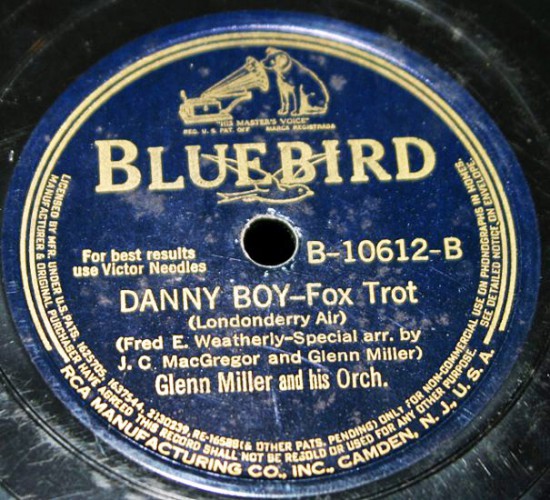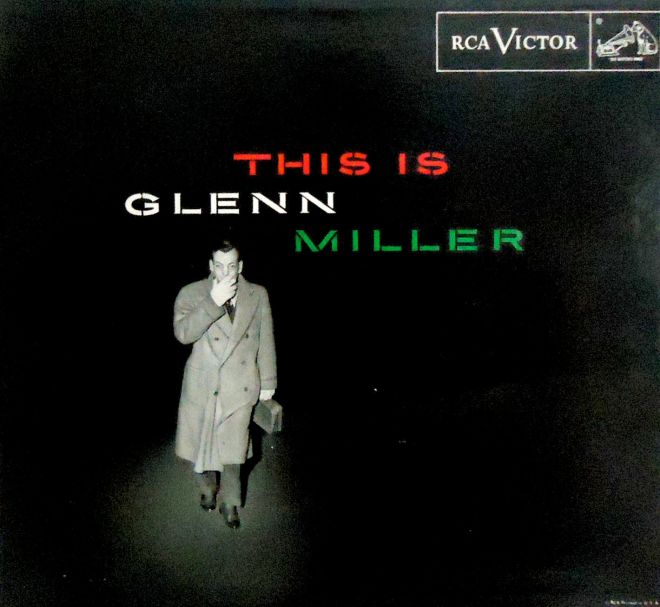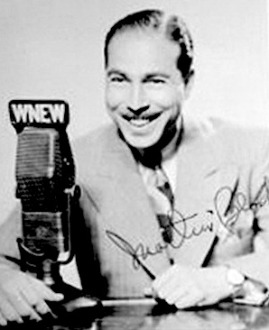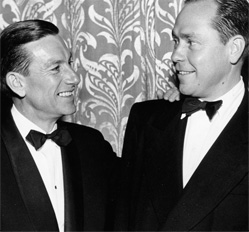Legh Knowles, Clyde Hurley, Dale “Mickey” McMickle, John Best (tp); Glenn Miller, Paul Tanner, Howard Gibeling, Frank D’Annolfo (tb); Hal McIntyre, Wilbur Schwartz, Jimmy Abato, Tex Beneke, Al Klink (reeds); Chummy MacGregor (p); Dick Fisher (g); Rollie Bundock (b); Maurice Purtill (d); Ray Eberle, Marion Hutton (vcl); Jerry Gray, Bill Finegan, Chummy MacGregor (arr).
RCA Victor Studios, New York – February 5, 1940, 1:00-4:45 PM
046784-1 Sweet Potato Piper (MH vcl, JG arr) Bluebird 10605
046785-1 Too Romantic (RE vcl) Bluebird 10605
046786-1 Tuxedo Junction (JG arr) Bluebird 10612 (gold label)
046786-2 Tuxedo Junction (JG arr) Bluebird 10612 (silver label)
046787-1 Danny Boy [Londonderry Air] (GM, ChM arr) Bluebird 10612
The February 5th, 1940 Glenn Miller session was another auspicious one, including a top Miller hit and one of the oldest, sweetest charts in the band’s library. First, however, were two new movie tunes from the first Bob Hope-Bing Crosby-Dorothy Lamour starrer, THE ROAD TO SINGAPORE. Dependable songwriters Johnny Burke and Jimmy Monaco crafted both. They had been turning out songs for Bing’s Paramount films for awhile and knew well how to bring out the best in his voice and manner.
SWEET POTATO PIPER, a trio in the movie for the three stars, works neatly as another Marion Hutton-Tex Beneke swing duet routine – “you can’t jam on a yam!” The modulation into the vocal is especially pleasant. Tex runs up and down the scale during his solo and ends with an upward gliss.
The film’s ballad, TOO ROMANTIC, begins with trombones leading into the reed sound. Ray Eberle warbles the vocal in a nicely plaintive manner and the coda is satisfyingly different.
Four days before the Miller recordings, Tommy Dorsey recorded these same two tunes for RCA with his brand-new vocalists, The Pied Pipers and Frank Sinatra, respectively. This die-hard Miller fan must admit that the Dorsey renditions are superior, with Johnny Mince joining the Pipers on an actual sweet potato instrument and Sinatra delivering the ballad slowly and with much feeling.
By now, Glenn was starting to fall into repetitive routines with his ballads and novelty tunes, recycling familiar passages, modulations and codas. Perhaps the band’s onerous schedule provided little time for Glenn and his arrangers to explore new creative avenues, especially on the recorded pop tunes. As 1940 continued, Glenn gave Bill Finegan and Jerry Gray some more leeway and their arrangements began to show greater imaginative scope.
Next on the session was a Miller blockbuster, TUXEDO JUNCTION. It’s a rare case of Glenn adapting another band’s hit into an even bigger one. Written by bandleader Erksine Hawkins and sidemen Julian Dash & Bill Johnson, it was recorded by Hawkins in July 1939 (on Glenn’s own Bluebird label!), becoming popular enough for the band to adopt it as their theme song. Sensing a potential hit song, the publisher had words added by Buddy Feyne, describing the Tuxedo Junction trolley crossing in Hawkins’ home town of Birmingham, Alabama.
In quick succession from January through March 1940, the tune was recorded by Al Donahue, Jan Savitt, then Glenn, followed by Harry James, Casa Loma and Gene Krupa. It shows how much clout Glenn had developed that he was allowed to record the number for the same label as Hawkins had, something that rarely occurred in those days.
Glenn had first picked up on JUNCTION when his band played opposite the Hawkins band at the Savoy Ballroom on Christmas Eve, 1939. Miller and Jerry Gray slowed the tempo down to a hypnotic lope, dropped most of the solos (except for Clyde Hurley’s emulation of Erskine’s original trumpet solo) and made it into more of an ensemble piece with repetitive riffs and blaring trumpets. Apparently this was just what the fans and dancers wanted, as the Miller record shot to Number One on the sales and popularity charts and was programmed often on their radio shows. The alternate take was apparently one of the few MIller alternates that was issued on 78 around the same time as the master take. There is little difference between the two versions.
On the flip side, DANNY BOY (aka LONDONDERRY AIR) was one of the earliest entries in the Miller band library. Jointly arranged by Glenn and Chummy MacGregor (who plays the celeste introduction, adding an ethereal touch), it is a brief, one-chorus rendition of the vintage ballad. Composed in 1910 by English musician Frederick Weatherly, it quickly became a favorite for Irish audiences, who always loved a sentimental melody. In Miller’s hands, muted brass and the reeds alternate passages, with Chummy tinkling in the background, leading to Glenn’s muted trombone at the end.
As a change of pace during stage shows, this lovely, quiet number would hold audience attention, especially when colored lighting effects were applied to highlight the various sections of the band.
We’ve heard from Ray Eberle only fleetingly during the last few sessions. He returns with a vengeance on the next two dates, singing on all but one of the upcoming records!

